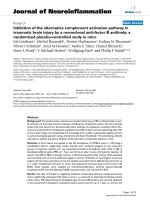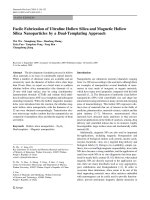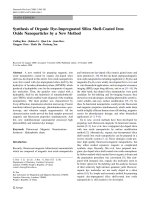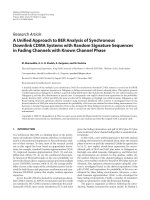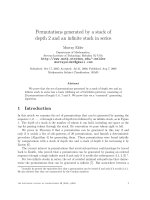2D simulation of nd2fe14bα fe nanocomposite magnets with random grain distributions generated by a monte carlo procedure
Bạn đang xem bản rút gọn của tài liệu. Xem và tải ngay bản đầy đủ của tài liệu tại đây (1.62 MB, 8 trang )
Hindawi Publishing Corporation
Journal of Nanomaterials
Volume 2012, Article ID 759750, 7 pages
doi:10.1155/2012/759750
Research Article
2D Simulation of Nd2Fe14B/α-Fe Nanocomposite Magnets with
Random Grain Distributions Generated by a Monte Carlo
Procedure
Nguyen Xuan Truong, Nguyen Trung Hieu, Vu Hong Ky, and Nguyen Van Vuong
Institute of Materials Science, Vietnam Academy of Science and Technology, 18 Hoang Quoc Viet, Cau Giay, Ha Noi 10000, Vietnam
Correspondence should be addressed to Nguyen Van Vuong,
Received 17 May 2012; Accepted 1 July 2012
Academic Editor: Yi Du
Copyright © 2012 Nguyen Xuan Truong et al. This is an open access article distributed under the Creative Commons Attribution
License, which permits unrestricted use, distribution, and reproduction in any medium, provided the original work is properly
cited.
The magnetic properties of Nd2 Fe14 B/α-Fe nanocomposite magnets consisting of two nanostructured hard and soft magnetic
grains assemblies were simulated for 2D case with random grain distributions generated by a Monte Carlo procedure. The effect
of the soft phase volume fraction on the remanence Br , coercivity Hc , squareness γ, and maximum energy product (BH)max has
been simulated for the case of Nd2 Fe14 B/α-Fe nanocomposite magnets. The simulation results showed that, for the best case,
the (BH)max can be gained up only a several tens of percentage of the origin hard magnetic phase, but not about hundred as
theoretically predicted value. The main reason of this discrepancy is due to the fact that the microstructure of real nanocomposite
magnets with their random feature is deviated from the modeled microstructure required for implementing the exchange coupling
interaction between hard and soft magnetic grains. The hard magnetic shell/soft magnetic core nanostructure and the magnetic
field assisted melt-spinning technique seem to be prospective for future high-performance nanocomposite magnets.
1. Introduction
The preparation of nanocomposite magnets containing
simultaneously both soft and hard magnetic phases is an
advanced technology that can enhance maximum energy
product (BH)max twice and thus keeps further the tendency
of the permanent magnet development which was going on
over last 30 years.
In principle, for the case of nanocomposite magnets, by
choosing the soft magnetic phase which has the saturation
magnetization, Jss , higher than that of the matrix of the hard
magnetic phase, Jsh , the higher total saturation magnetization, Js , can be achieved. Besides, for this nanocomposite
magnet, the related magnetic moment reversal mechanism,
which can provide the total magnetic remanence value, Br ,
larger than that of the pure hard magnetic phase, Brh , should
be taken in to account. Thus, the suitable nanostructured
microstructure of the nanocomposite magnet consisting of
the soft and hard magnetic phases can be obtained by
controlling the magnet microstructure with regards to the
related moment reversal mechanism. In this ideal case,
the coercivity b Hc of the nanocomposite magnet can be
remained while the maximum energy product (BH)max can
be enhanced up to the upper limit of (Br )2 /4 µo .
The theory for one dimension case [1] has explained
this enhancement by accounting the hardening process of
fine soft magnetic particles that occurred under the exchange
coupling of hard magnetic grains. This theory requires the
soft magnetic grain size to be less than the critical value δcm =
π(Am /2Kh )1/2 , where Am is the soft magnetic phase exchange
energy, and Kh is the hard magnetic phase anisotropy energy
with Am = 10−11 J/m and Kh = 2.106 J/m3 , respectively, for
α-Fe and Nd2 Fe14 B.
Numerous theoretical works [2–5] have shown the ability
of obtaining a large value of (BH)max for modeled regular
nanostructured configurations. However, up to date, the
experimental studies reported that the (BH)max value is still
less than 200 kJ/m3 [6–20].
This paper presents 2D simulation of Nd2 Fe14 B/α-Fe
nanocomposite magnets by using Monte Carlo method. The
Journal of Nanomaterials
200
200
150
150
b (nm)
b (nm)
2
100
100
50
50
0
−100
0
100
200
a (nm)
300
400
0
500
−100
0
(a)
100
200
a (nm)
300
400
500
(b)
Figure 1: (a) The soft magnetic grains (red) are randomly distributed in the hard magnetic phase matrix (white). (b) Some sets of closed
three and more soft magnetic grains (yellow) will be replaced by the one new grain with the area conservation rule. The blue parts are the
parts of the soft magnetic particles hardened under the exchange coupling interactions.
Table 1: Magnetic parameters of hard grains, soft grains, and soft grains which are hardened under the exchange coupling interactions.
Type of grains
Saturation
magnetization
Js (T)
Remanent
magnetization
Jr (T)
Coercivity
i Hc (kA/m)
Coercivity Squareness
γ
b Hc (kA/m)
Energy
product
(BH)max
(kJ/m3 )
Parts of hard magnetic grains
1.61
1.3
960
880
0.92
300
Parts of soft magnetic grains
2.15
1.978
0.0
0.0
—
0.0
Parts of soft magnetic grains which are
hardened under the exchange coupling
interaction
1.61
1.3
960
880
0.92
300
simulation results allow to find out the answer how difficult
to prepare the high quality nanocomposite magnets. The
paper also suggests the way to get high quality hard/soft
magnetic two-phase nanostructure by using an external
magnetic field to assist the formation of this structure.
2. 2D Simulation Algorithm
Considering the case of which the soft magnetic α-Fe grains
are randomly dispersed into a two-dimensional (2D) magnet
with sizes a, b of the Nd2 Fe14 B hard magnetic phase as
presented in Figure 1. The number of the soft magnetic
grains is suggested to be large enough to apply Gaussian
function to their grain size distribution.
The simulation algorithm is as follows.
(i) Using the special random number generator with
Gaussian statistics [21] to “spray” the assembly of
the soft magnetic α-Fe grains (with the mentioned
Gaussian distribution function) and the hard magnetic Nd2 Fe14 B matrix to build up Nd2 Fe14 B/α-Fe
nanocomposite microstructure.
(ii) Inspecting all the soft magnetic grains. If three or
more grains are placed closely with one another on
the given distance ε, then they will be replaced by
bigger grains with the effective diameter defined by
the area conservation.
(iii) The Monte Carlo probability bin of the hardening
process of the soft magnetic grains is chosen on
the basics of the Kneller-Hawig criterion [1]. It was
suggested that the exchange coupling interaction
of the hard phase is expanded into the soft phase
keeping continuously on the distance of order of the
hard magnetic phase domain wall width δcm .
(iv) In the common case, there are three kinds of grains:
the origin hard magnetic grains, the original soft
magnetic grains, and the hardened soft grains. Correspondingly, we have three types of the magnetization
loops: the origin hard phase loop J h (H), the origin
soft phase loop J s (H), and the loop J hs (H) of the parts
of soft grains which are hardened under the exchange
coupling with the hard grains. The loop J h (H) of
Nd2 Fe14 B is chosen with properties consequently
observed in practice: Jsh = 1.61 T, Jrh = 1.3 T, i Hch =
960 kA/m, b Hch = 880 kA/m, squareness γ = 0.92, and
(BH)max = 300 kJ/m3 . The loop of hardened grains
J hs (H) is suggested to have the intrinsic coercivity i Hch
and the squareness γ like those of the hard magnetic
phase. The remanence of the soft phase Jrs = γJss with
Jss = 2.15 T is selected for the case of α-Fe. For clarity,
the main magnetic properties of these three parts of
grains are listed in the Table 1.
The total loop of the 2D nanocomposite magnet is then
calculated by averaging all the loops with weighted factors of
the volume fractions of three kinds mentioned above.
We present below the simulating results with a = 80δcm ,
b = 40δcm and ε was taken to be equal 0.3δcm with δcm =
5 nm.
80
40
0
0
320
−100
360
(BH)max (kJ/m3 )
280 240 200 160 120
−200
400
1.5
−800
3
−900
Journal of Nanomaterials
1.5
J (T), B (T)
1
J (T)
0.5
0
−0.5
1
0.5
1000
−300
500
−400
0
H (kA/m)
−500
−500
−600
−1000
−700
0
−1.5
−1000
−1
H (kA/m)
(a)
(b)
Figure 2: (a) The magnetization loops J hs of the magnet (sky-blue) and J h of the origin hard phase Nd2 Fe14 B (red); (b) the demagnetization
curves J(H) (sky-blue), B(H) (blue), and (BH)max curve (red) of the Nd2 Fe14 B/α-Fe magnet.
3. Results and Discussion
3.2. Effects of the Soft Magnetic Phase Volume Fraction
on Magnetic Properties of the Nanocomposite Magnet. The
dependence of magnetic properties on the soft magnetic
phase volume fraction ξ is crucial for nanocomposite
magnets. It is worthy to note that ξ is the function of two
variables, the number and sizes of grains. For the same
value of ξ, the number of grains and grain sizes can be
different thus lead to the different option of implementing
the Kneller-Hawig criterion, and thus lead to the dispersion
of the magnetic properties of different samples prepared by
different routes but with the same soft phase volume fraction.
This behavior was observed in our simulation results.
The ξ-dependent magnetic properties are presented on
Figure 3, and it shows clearly their complicated feature which
can be summarized as follows.
(1) A large dispersion of (BH)max is observed for ξ >
20%. This phenomenon might be caused mainly by
the dispersion of Jr (up to 10% of its maximum
400
380
(BH)max (kJ/m3 )
3.1. Exchange Coupling Nature. Simulation data proved
the significant enhancement in magnetic properties of
nanocomposite magnets in the case that a large total volume
fraction of the magnets is occupied by the fine soft magnetic
grains. The typical example is shown in Figures 2(a) and
2(b). In this case, the soft phase volume fraction is 33%, 700
α-Fe grains with the averaged particle size of 6.75 nm, and
the half-width, σ, of the Gaussian distribution is 0.5.
The magnetization loop presented in Figure 2(a) shows
the conventional single phase behavior, which corresponds
to the fully hardening of all soft grains. The demagnetization
curve together with the (BH)max versus the external magnetic
field curve is shown in Figure 2(b). This magnet has the
remanence Jr = 1.46 T and (BH)max = 370 kJ/m3 that was
enhanced by 12 and 23%, respectively, in comparison with
ones of pure Nd2 Fe14 B hard phase.
360
340
320
300
280
0
10
20
30
40
50
Soft phase volume fraction (vol.%)
60
Figure 3: The simulated dependence of (BH)max on the soft phase
volume fraction ξ.
value), the dispersion of b H c (7%), and the dispersion
of i H c (small, within 1% only).
(2) The optimal value of ξ for the given simulated
magnet is about 50%. For ξ > 50%, all of the
magnetic performances became worse.
(3) For ξ < 50%, the dashed curve presented in Figure 3
corresponds to the upper limit of the enhancements
of the magnetic properties. So, for the given magnet,
(BH)max can be gained up only 30% at ξ = 50%.
3.3. The Dependence of Magnetic Properties on the Grain
Size. Based on the Kneller-Hawig theory, it is clear that the
quality of nanocomposite magnets depends mainly on the
two parameters of the soft magnetic phase: volume fraction
and grain size. The volume fraction must be large enough
to increase the remanence, and the grain sizes must be small
enough for strengthening the hardening process.
4
Journal of Nanomaterials
960
1.55
958
956
Jr (T)
i Hc
(kA/m)
1.5
1.45
954
1.4
952
950
4
6
8
10
12
D (nm)
14
16
18
1.35
4
6
8
(a)
10
12
D (nm)
14
16
18
(b)
420
400
(BH)max (kJ/m3 )
380
360
340
320
300
280
260
4
6
8
10
12
D (nm)
14
16
18
(c)
Figure 4: The effect of the soft phase grain size on (a) coercivity i Hc , (b) remanence Jr , and (c) (BH)max .
Figure 4 shows the dependence of the magnetic properties on the grain size D. The value of 40% of ξ was kept
constant during the simulation, the other input data are the
same as those mentioned in Section 3.1. It is interesting to
note that, for the given configuration of the magnet, the
intrinsic coercivity i H c is nearly independent on the soft
magnetic grain size. In contrast, the remanence Jr and the
maximum energy product (BH)max reach maximum values
for D < 2δcm (=10 nm in this case) and linear dependent on
the grain size in the range D > 2δcm (from 10 to 16 nm) with
the slopes of −0.026 T/nm and −18.6 kJ/m3 /nm, respectively.
4. The Hard Magnetic Shell/Soft Magnetic
Core Nanostructure
The large dispersion observed in Figure 3 belongs to the
random behavior of the distribution of soft magnetic grains
in the hard magnetic phase matrix which can form a large
soft phase cluster. This effect is described in the second step
of the given algorithm. In practice, the effect of increasing
in randomness on soft magnetic grain size is closely related
to interdiffusion of Fe/Co in the ball-milled Nd-Fe-B/α-Fe
or Sm-Co/α-Fe systems. In melt-spun ribbons, this effect is
raised up due to the splitting of the CCT (Continuous Cooling Transformation) curves of the soft and hard magnetic
phases. In hot compacted nanocomposite magnets, this effect
also relates to the soft phase interdiffusion process.
The effect of soft phase cluster formation disturbs the
Kneller-Hawig criterion and diminishes the exchange coupling, making the nanocomposite magnet become a mixture
of hard and soft phases with poor magnetic properties. To
avoid this effect, one can use the nanocomposite structure of
hard shell/soft core. In this configuration, the soft phase is
confined inside the hard shell and the soft cluster cannot be
formed. Moreover, under the protection of hard shell, instead
Journal of Nanomaterials
5
20
M (A∗m2 /kg)
15
10
5
0
0
100
200
300
T (◦ C)
400
500
600
Figure 5: The M(T) curve of the nanocomposite ribbon sample with the hard shell/soft core nanostructure. The sample was demagnetized
thermally. The measuring magnetic field was 40 kA/m. The temperature was cycled between the room temperature and 600◦ C.
of being subjected to the external magnetic field, the soft core
magnetization follows the magnetization of hard shell which
allows keeping the coercivity of magnets at high values.
A technology which provides the hard magnetic shell/soft
magnetic core is the magnetic field assisted melt-spinning
technique [22]. For Nd-Fe-B/α-Fe system, during the field
assisted melt-spinning process, the α-Fe seeds are formed
initially on the wheel surface, the hard magnetic Nd-Fe-B
grains are then grown on the seed along the (00l) direction
and perpendicular to the ribbon free surface. As mentioned
in [22], the magnetic field increases the energy inside the
volume of seeds and thus decreases the critical size of seeds
and, consequently, the average grain size.
In our experimental work, the hard magnetic shell/soft
magnetic core nanostructure is realized by melt-spinning
the alloy Nd16 Fe76 B8 + 40 wt.% Fe65 Co35 with an external
magnetic field, Hex = 0.32 T. The dependence of the magnetization on temperature was measured in the magnetic field of
40 kA/m from Troom to 600◦ C and vice versa and is presented
in Figure 5. During the heating stage, the hard magnetic shell
protects the soft magnetic core from the external magnetic
field and the magnetization of sample is increased gradually,
reaching the maximum value at the Curie temperature of the
Co-containing hard magnetic phase. After reaching 400◦ C,
the hard magnetic shell is degraded totally and as a result,
only the bare soft magnetic core is left but the magnetization
is kept at the value around 2 A∗m2 /kg, then increased
continuously and reached the saturation when T is reaching
the Tc of the soft magnetic phase. By cooling from 600◦ C,
the magnetization that existed inside the bare soft magnetic
phase is increased normally until 395◦ C where the hard
magnetic shell restores its own hard magnetic properties.
This hard magnetic shell/soft magnetic core realizes a good exchange coupling interaction that keeps
the remanence about of 0.99 T, i H c ∼ 675 kA/m, and
(BH)max ∼ 140 kJ/m3 for the ribbon melt-spun at the speed
of 30 m/s. The loops of prepared ribbons melt-spun at
different wheel speeds are presented in Figure 6(a). The
hysteresis curve of optimal sample at v = 30 m/s is smooth,
indicating the existence of an exchange coupling between
the hard and soft magnetic phases. This obtained (BH)max
value of 140 kJ/m3 of our work is an encouraging result and
approached to that reported by other research groups [6–20]
while using a rather simple preparation method.
The simple calculation in the framework of the model
of spherical soft core covered entirely by the hard shell
showed that the upper limit of the volume fraction of
the soft phase is about 60%. The thickness of the hard
magnetic shell in this case reaches about 2 nm, the size of
the superparamagnetic state for Nd2 Fe14 B. This value, 60%,
is greater than the limit 50% mentioned above for the case
of random distribution of hard and soft grains. Thus, it is
quite reasonable to expect that the optimized magnetic field
assisted melt spinning method is promising to prepare high
performance nanocomposite magnets.
5. Conclusion
The magnetic properties of nanocomposite magnets have
been simulated with random grain distributions generated
by a Monte Carlo procedure. The simulation results for
the case of Nd2 Fe14 B/α-Fe showed the ability of enhancing the magnetic performance of magnet. However, the
enhancement is not crucial as predicted theoretically. For the
tested magnet configuration, the maximum energy product
(BH)max can be enhanced only by about 30% of the value of
the origin Nd2 Fe14 B hard magnetic phase. The upper limit
of α-Fe phase volume fraction is found to be about 50%,
and beyond this value the (BH)max decreases abruptly. At
the fixed values of the α-Fe, the magnetic properties exhibit
a large dispersion depending on the soft magnetic cluster
formation. For further increase of (BH)max of nanocomposite magnets, it is suggested to use the hard shell/soft core
nanostructure. This nanocomposite configuration with large
6
Journal of Nanomaterials
180
−150
−125
(BH)max (kJ/m3 )
−100
−75
−50
−25
0
1.2
135
M (A∗m2 /kg)
45
0.8
0
0.6
−45
0.4
−90
−135
−180
−4000
M (T), B (T)
1
90
0.2
−2000
0
H (kA/m)
2000
0
4000
v = 25 m/s
v = 30 m/s
v = 35 m/s
−800
−700
−600
−500
−400
−300
−200
−100
0
H (kA/m)
(BH)max
M(H)
B(H)
(a)
(b)
Figure 6: (a) The loops of the nanocomposite ribbons melt-spun at different wheel speeds, v = 20, 25, 30 m/s. (b) The M(H) and B(H) and
(BH)max of the high performance ribbon melt-spun at the optimal wheel speed 30 m/s.
soft phase volume fraction is suggested to be prepared by
means of the magnetic field assisted melt-spinning technique.
[7]
Acknowledgment
This research is supported by Vietnam’s National Foundation
for Science and Technology Development (NAFOSTED),
code: 103.02-2010.05.
[8]
References
[9]
[1] E. F. Kneller and R. Hawig, “The exchange-spring magnet: a
new material principle for permanent magnets,” IEEE Transactions on Magnetics, vol. 27, no. 4, pp. 3588–3600, 1991.
[2] R. Skomski and J. M. D. Coey, “Giant energy product in nanostructured two-phase magnets,” Physical Review B, vol. 48, no.
21, pp. 15812–15816, 1993.
[3] T. Schrefl and J. Fidler, “Modelling of exchange-spring permanent magnets,” Journal of Magnetism and Magnetic Materials,
vol. 177–181, no. 2, pp. 970–975, 1998.
[4] H. Fukunaga and H. Nakamura, “Computer simulation of
magnetic properties of anisotropic nanocomposite magnets,”
IEEE Transactions on Magnetics, vol. 36, no. 5, pp. 3285–3287,
2000.
[5] J. Fidler, T. Schrefl, W. Scholz, D. Suess, R. Dittrich, and
M. Kirschner, “Micromagnetic modelling and magnetization
processes,” Journal of Magnetism and Magnetic Materials, vol.
272–276, pp. 641–646, 2004.
[6] Z. Chen, Y. Zhang, G. C. Hadjipanayis, Q. Chen, and B. Ma,
“Effect of wheel speed and subsequent annealing on the
microstructure and magnetic properties of nanocomposite
[10]
[11]
[12]
[13]
Nd2 Fe14 B/α-Fe magnets,” Journal of Magnetism and Magnetic
Materials, vol. 206, no. 1, pp. 8–16, 1999.
´
G. Mendoza-Su´arez, J. I. Escalante-Garc´ıa, J. Lopez-Cuevas,
G. Vargas-Guti´errez, H. Mancha-Molinar, and J. MendezNonell, “Effect of roll speed on the magnetic properties of
nanocomposite PrFeB magnets prepared by melt-spinning,”
Journal of Magnetism and Magnetic Materials, vol. 206, no. 1,
pp. 37–44, 1999.
A. Melsheimer, M. Seeger, and H. Kronmuller, “Influence of
Co substitution in exchange coupled NdFeB nanocrystalline
permanent magnets,” Journal of Magnetism and Magnetic
Materials, vol. 202, no. 2, pp. 458–464, 1999.
C. J. Yang and E. B. Park, “Enhancement of magnetic
properties of Fe3 B/Nd2 Fe14 B magnet by the addition of Co,”
IEEE Transactions on Magnetics, vol. 35, no. 5, pp. 3328–3330,
1999.
W.-Y. Zhang, S.-Y. Zhang, A.-R. Yan, H.-W. Zhang, and
B.-G. Shen, “Effect of the substitution of Pr for Nd on
microstructure and magnetic properties of nanocomposite
Nd2 Fe14 B/α-Fe magnets,” Journal of Magnetism and Magnetic
Materials, vol. 225, no. 3, pp. 389–393, 2001.
A. Arai, H. Kato, and K. Akioka, “High-energy isotropic
resin bonded magnets produced from (Nd,Dy)-(Fe,Co)-B
nanocomposite alloys,” IEEE Transactions on Magnetics, vol.
37, no. 4, pp. 2555–2557, 2001.
L. Shandong, D. Yaodong, B. X. Gu, T. Zongjun, and D.
Youwei, “Effect of amorphous grain boundaries on the
magnetic properties of B-rich nanocomposite permanent
magnets,” Journal of Alloys and Compounds, vol. 339, no. 1-2,
pp. 202–206, 2002.
M. Daniil, Y. Zhang, H. Okumura, G. C. Hadjipanayis, and
D. J. Sellmyer, “Effect of grain growth inhibitors on the
hysteresis properties of Nd10 Fe82 C6 B2 melt-spun alloys,” IEEE
Transactions on Magnetics, vol. 38, no. 5, pp. 2973–2975, 2002.
Journal of Nanomaterials
[14] Y. Sen, S. Xiaoping, and D. Youwei, “Exchange coupled Nd2 Fe14 B/α-Fe nanocomposite magnets with fine α-Fe
grains,” Microelectronic Engineering, vol. 66, no. 1–4, pp. 121–
127, 2003.
[15] D. N. Brown, Z. Chen, P. Guschl, and P. Campbell, “Developments with melt spun RE-Fe-B powder for bonded magnets,”
Journal of Magnetism and Magnetic Materials, vol. 303, no. 2,
pp. e371–e374, 2006.
[16] W. Chen, X. Zhao, J. J. Hu et al., “Refinement of the microstructure and enhancement of the magnetic properties
in α-Fe/(Nd,Dy)2 Fe14 B nanocomposite using the two-step
annealing technique,” Journal of Magnetism and Magnetic
Materials, vol. 306, no. 1, pp. 51–54, 2006.
[17] Z. Q. Jin, H. Okumura, Y. Zhang, H. L. Wang, J. S. Muoz, and
G. C. Hadjipanayis, “Microstructure refinement and significant improvements of magnetic properties in Pr2 Fe14 B/αFe nanocomposites,” Journal of Magnetism and Magnetic
Materials, vol. 248, no. 2, pp. 216–222, 2002.
[18] D. Sultana, M. Marinescu, Y. Zhang, and G. C. Hadjipanayis, “Isotropic nanocomposite Pr-Fe-Co-B ribbons with
(BH)max > 20 MGOe,” Physica B, vol. 384, no. 1-2, pp. 306–
309, 2006.
[19] Z. W. Liu and H. A. Davies, “The practical limits for enhancing
magnetic property combinations for bulk nanocrystalline
NdFeB alloys through Pr, Co and Dy substitutions,” Journal
of Magnetism and Magnetic Materials, vol. 313, no. 2, pp. 337–
341, 2007.
[20] X.-R. Zeng, H. C. Sheng, J. Z. Zou, and S. H. Xie, “New
crystallographic textures of Nd2 Fe14 B/α-Fe nanocomposite
materials prepared by controlled melt spinning,” Materials
Science Forum, vol. 654-656, pp. 1170–1173, 2010.
[21] N. V. Vuong, N. V. Khanh, and D. M. Thuy, “Simulation of
the energy product (BH)max of Nd-Fe-B anisotropic bonded
magnets,” Physica B, vol. 327, no. 2–4, pp. 349–351, 2003.
[22] N. V. Vuong, C. Rong, Y. Ding, and J. Ping Liu, “Effect
of magnetic fields on melt-spun Nd2 Fe14 B-based ribbons,”
Journal of Applied Physics, vol. 111, no. 7, pp. 07A731-1–
07A731-3, 2012.
7
Journal of
Nanotechnology
Hindawi Publishing Corporation
Volume 2014
International Journal of
International Journal of
Corrosion
Hindawi Publishing Corporation
Polymer Science
Volume 2014
Hindawi Publishing Corporation
Volume 2014
Journal of
Smart Materials
Research
Hindawi Publishing Corporation
Composites
Volume 2014
Hindawi Publishing Corporation
Volume 2014
Journal of
Metallurgy
BioMed
Research International
Hindawi Publishing Corporation
Volume 2014
Nanomaterials
Hindawi Publishing Corporation
Volume 2014
Submit your manuscripts at
Journal of
Materials
Hindawi Publishing Corporation
Volume 2014
Journal of
Nanoparticles
Hindawi Publishing Corporation
Volume 2014
Nanomaterials
Journal of
Advances in
Materials Science and Engineering
Hindawi Publishing Corporation
Volume 2014
Scientifica
Hindawi Publishing Corporation
Volume 2014
Hindawi Publishing Corporation
Volume 2014
The Scientific
World Journal
Hindawi Publishing Corporation
Journal of
Journal of
Journal of
Journal of
Nanoscience
Coatings
Crystallography
Ceramics
Hindawi Publishing Corporation
Volume 2014
Hindawi Publishing Corporation
Volume 2014
Hindawi Publishing Corporation
Volume 2014
Hindawi Publishing Corporation
Volume 2014
International Journal of
Biomaterials
Hindawi Publishing Corporation
Volume 2014
Journal of
Textiles
Volume 2014
Hindawi Publishing Corporation
Volume 2014

